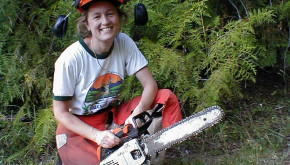
My forest “aha!” moment is this advice from our extension forester: “Safety first!” Safety is key when you work in the forest.
Through University of Idaho Extension, about 2001 or 2002, I was taking a class on pruning White Pine to reduce the risk of blister rust infection. Pruning didn’t seem to present many safety hazards, yet our teacher emphasized safety.
There are all the things that can go wrong that you didn’t know could go wrong until they do go wrong—and then it is too late.
Professor Schnepf, our University of Idaho Extension Forester, had brought equipment for show-and-tell at our pruning class. He held up a three-in-one. “You’ve got it all here: face shield, head muffs, and hard hat.” All you have to do is put on one piece of safety gear because the face shield and the ear muffs are connected to the hard hat. Don’t forget to add the chaps and solid boots. Leather gloves are also essential.
But he didn’t just hold up equipment. I watched Forester Schnepf physically demonstrate the way a branch could fall on your head or a twig could snap up from the saw to scrap your eye. He showed the way a saw could slip off a downed tree—in the demo, the saw was turned off—and how easily that saw could deconstruct your thigh.
In the class, when we started going over thinning a stand, using a chainsaw or a brush saw, our forester emphasized that if you were starting out, you might want to try a brush saw for thinning (rather than a chain saw). “If you fall,” he said, “the brush saw blade is far enough out that it won’t take off a body part.”
I’ve since fallen, while using my brush saw in the rain on a steep hillside. The wand of the brush saw meant the blade was far away from my body. But on my brush saw, there is no safety shut off to stop the blade, like on a chain saw, so the blade keeps spinning. You’ve got to shove your sharpened blade into the ground to stop the revolutions. Somehow when I fell, sliding down the hill, smashing my chest into the ground, I was able to click the off button and shove the blade into the ground to stop it spinning. But I didn’t come close to losing any body parts. Just bruised my chest.
Way back when, after that class on pruning, I bought chaps and a hard hat with face shield and ear muffs (often called a “three-in-one”). I asked seasoned foresters and loggers and forest owners for advice. Everyone I asked emphasized safety. Wives of loggers came up to me at church and asked if I was being safe. “Do you use chaps, eye protection, a hard hat, something for your ears, my dear?”
I’ve yet to overcome my fear of chainsaws and am still practicing, slowly getting more comfortable. I turn it on, and I practice using the safety stop. I have not felled big trees. But I’ve had branches fall on my head, simply while thinning using the brush saw, because the dog-hair thicket was so dense, I didn’t see, and could not have seen, the branch hung up in the truncated canopy of suppressed trees. That hard hat saved my head as the tree branch bonked me.
Safety first! Things can happen unpredictably, and safety preparation means you are less likely to hurt yourself. And take a look at the area where you are working. Look up. Look down. My blade has discovered buried, rusted barbed wire that was surely tetanus-shot worthy. Get yourself a tetanus shot.
I’m not sure why my “aha!” moment was all about safety. I grew up watching my father take down trees for our winter wood. I knew not to surprise my dad while he was working with power tools. I knew to stand away and let a working person see you. But I didn’t have much experience handling power tools myself. The transition from observer to doer, from watching my dad do it to doing it myself, really hit me hard. I could see blood spurting out of my thigh. I could see body parts shredding, fingers flying into the forest.
Don’t let that happen. Don’t skimp on safety. Safety is key when you work in the forest.

